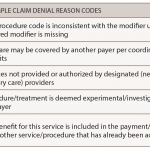
Image Credit: Pixelbliss/shutterstock.com
One month has passed since the U.S. healthcare system overcame a historical milestone with the conversion from billing ICD-9-CM to ICD-10-CM. Although the transition to ICD-10 had a major impact on coding operations, its far-reaching tentacles go beyond coding alone and are deeply rooted in the entire revenue cycle. There is room to criticize the new codeset, but don’t be so jaded by the transition of ICD-10 to think it’s the only effect on the revenue cycle management. If we take a closer look, we see that this is something we have been struggling with since long before the introduction of ICD-10.
So what is the revenue cycle? It’s defined as, “All administrative and clinical functions that contribute to the capture, management and collection of patient service revenue.”1 Multiple functions included in the revenue cycle have to be performed at optimal levels by everyone in the practice, involving providers, managers and staff. Everyone providing patient contact should understand their role in the revenue cycle and reimbursement. Relevant areas include:
- Front end (scheduling, patient intake, registration, eligibility, benefits);
- Providers (physicians, nurses, other ancillary staff);
- Coding and billing (charge entry, coders, billers, practice managers); and
- Back end (payment posting, accounts receivable, prior authorizations, denials and appeals).
Understanding and analyzing key areas of the practice will help with resolving issues and encourage proper communication across departments to alleviate the administrative hurdles in charge capturing and revenue cycle management. Communication is a major component in shrinking any revenue leakage in the practice.
Although there are many reasons for a rejection or a denial, these lead to issues with a practice’s revenue cycle & its bottom line.
Understanding the Front End
Broad categories of the front-end role in the revenue cycle include scheduling, precertification, preregistration, patient co-pay/co-insurance and registration. The revenue cycle begins at scheduling and has a major effect on the next steps in collecting patient demographics and insurance information. Front-end staff should understand what information must be collected at scheduling for patient eligibility, medical necessity and payer-specific reimbursement policy verification as part of the process in submitting a clean claim for timely reimbursement. Because front-end staff members are not intimately involved in handling denials due to incorrect patient information, there should be a process of communicating the data in an effort to correct the problem and improve the process.
Another key area to address for front-end staff is upfront collections, because there continue to be missed opportunities to collect on patient liability. Post-insurance balances are a big component of medical practice bad debt. Front-end staff should have a clear understanding of patient responsibility for out-of-pocket expenses, co-pay and co-insurance, which should be collected at the time of service.
The Middle Man
Clinical staff play an important role in charge capturing and reconciliation, because they have the knowledge of the services rendered and are the best resource to validate the charges. Also, understanding the new code list and the documentation required by providers to be able to reach a valid code will have an impact on billing a clean claim. Clinical documentation improvement plays a vital role in ensuring that physicians have the right tools at hand to document effectively and not hold up claims in the system due to physician querying for accurate coding. It’s important to note that this is needed for the coding specificity to ensure accurate coding and minimize any rejections or denials. Practices should have a solid communication plan in place for training and educating the providers on how to document to get the most specific code and all other coding changes that will affect how claims are billed. One proactive approach in assisting providers with capturing the most accurate information is utilizing tools in the electronic medical record to give prompts or coding notes for certain diagnoses or procedures.
It’s helpful for the clinical staff to understand the process, and one way to accomplish this is to run a revenue and usage report to see the impact of the denials management or revenue reduction or decrease.
Denials Management & the Back End
Handling claims denials and rejections is the largest function of back-end staff. Claims denials and rejections are some indicators of issues within the process, because they take on many forms. A rejection indicates that there is a problem and is sent back to the provider before hitting the payer system. Conversely, denials signify that the payer found an error with the coding. Common denials or rejections seen on the back end include, but are not limited to, inaccurate demographics, inaccurate or missing authorizations, unbundling of codes and lack of medical necessity. Although there are many reasons for a rejection or a denial, these lead to issues with a practice’s revenue cycle and its bottom line.
Common denials or rejections seen on the back end include, but are not limited to, inaccurate demographics, inaccurate or missing authorizations, unbundling of codes & lack of medical necessity.
Coders, billers and payment posters see firsthand the errors that cause the rejection or the denials and have the responsibility to share with providers and other staff. Coding experts should meet with providers and ancillary staff to share coding errors and recommendations for improvement.
Prioritization is vital to improve denials management; back-end staff can create a process or workflow to handle denials/rejections as well as to track any payer trends. It is a good idea to identify and work on high-dollar claims or the largest payer, as these tend to have the biggest influence on a practice’s bottom line and if addressed in a timely manner, can speed up cash flow. Other areas to break down denial/rejection trends for enhanced denials management include medical necessity, bundled services, coding specificity, etc.
Close the Gap
The revenue cycle management is a multifaceted area and requires everyone to play their part in addressing the practice’s needs. Below are some key points practices can use to assist with their daily business process:
- Ensure front-end staff are trained and understand the eligibility verification process, collecting co-pays up front, prior authorizations, managing referrals and the practice’s financial policy.
- Maintain current contracting and payer manual updates, especially for prior authorization, as well as payer policies and regulations.
- Strengthen denial management processes where denial outcomes are shared with all departments; focus on identifying where coding training gaps have created denials.
- Create and/or monitor clinical documentation improvement for providers to address coding guidelines for appropriate clinical information and accurate code assignment.
- Pull monthly/quarterly reports to review A/R in an effort to manage denials in a timely manner.
The healthcare revenue cycle component is active and heavily regulated, and adjustments to reimbursement in the delivery system for provider services continue to have major impacts on the financial performance of physician practice. Thus, it is imperative that the entire revenue cycle function is streamlined to be as effective and efficient as possible. All areas of the practice must work together in order to achieve the best outcome. Providers and practice managers play a key role in encouraging communication and process improvement to reduce denials and rejections, which affect the revenue cycle. Practices should provide consistent and regular training on all areas of the practice and the effect they have on the revenue cycle management.
For questions, additional information or training on the revenue cycle management, contact the ACR practice management staff at [email protected] or 404-633-3777.
Reference
- Walker Keegan D, Woodcock EW, Larch SM. The Physician Billing Process: 12 Potholes to Avoid in the Road to Getting Paid, 2nd ed. Englewood, Colo.: Medical Group Management Association, 2009.



